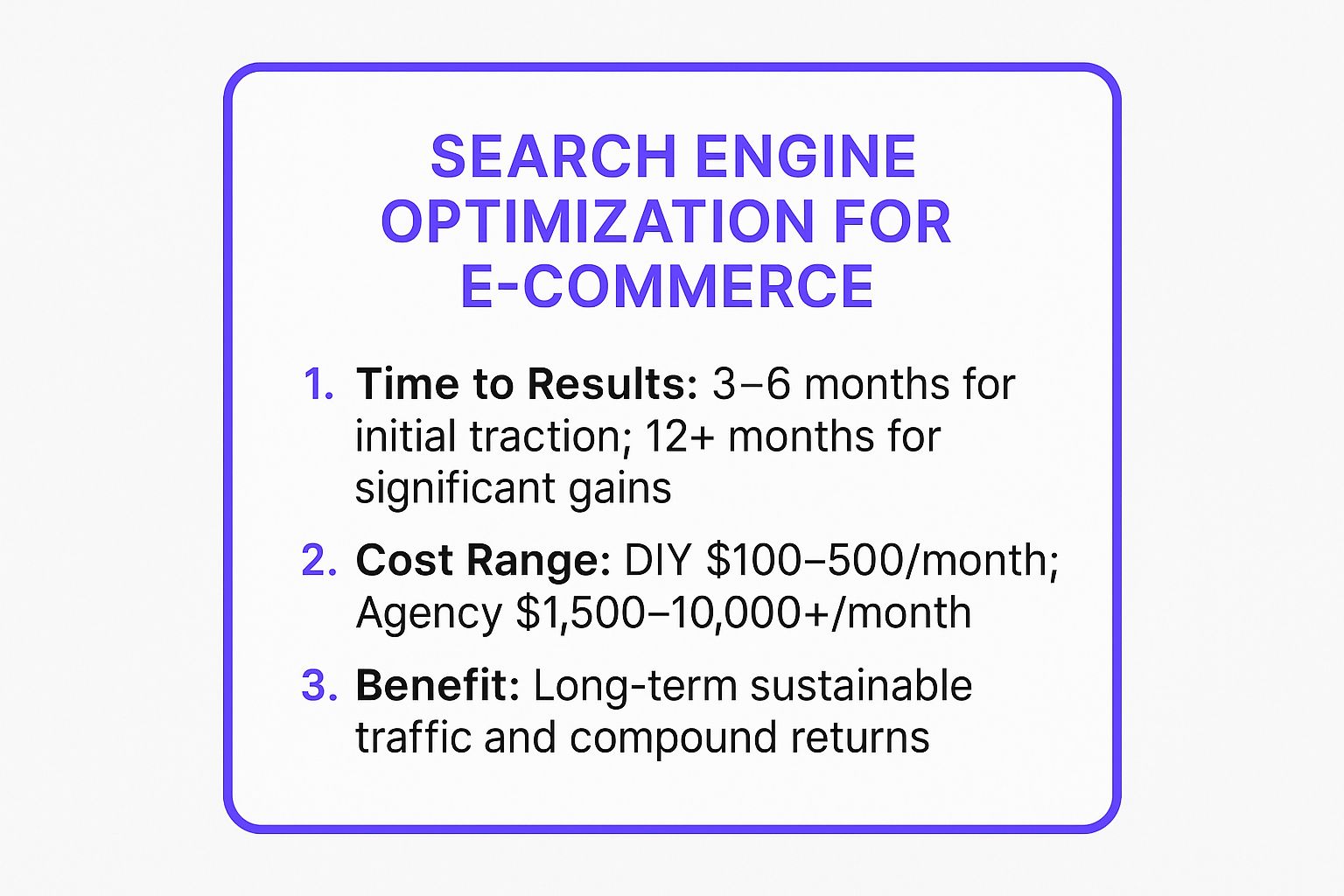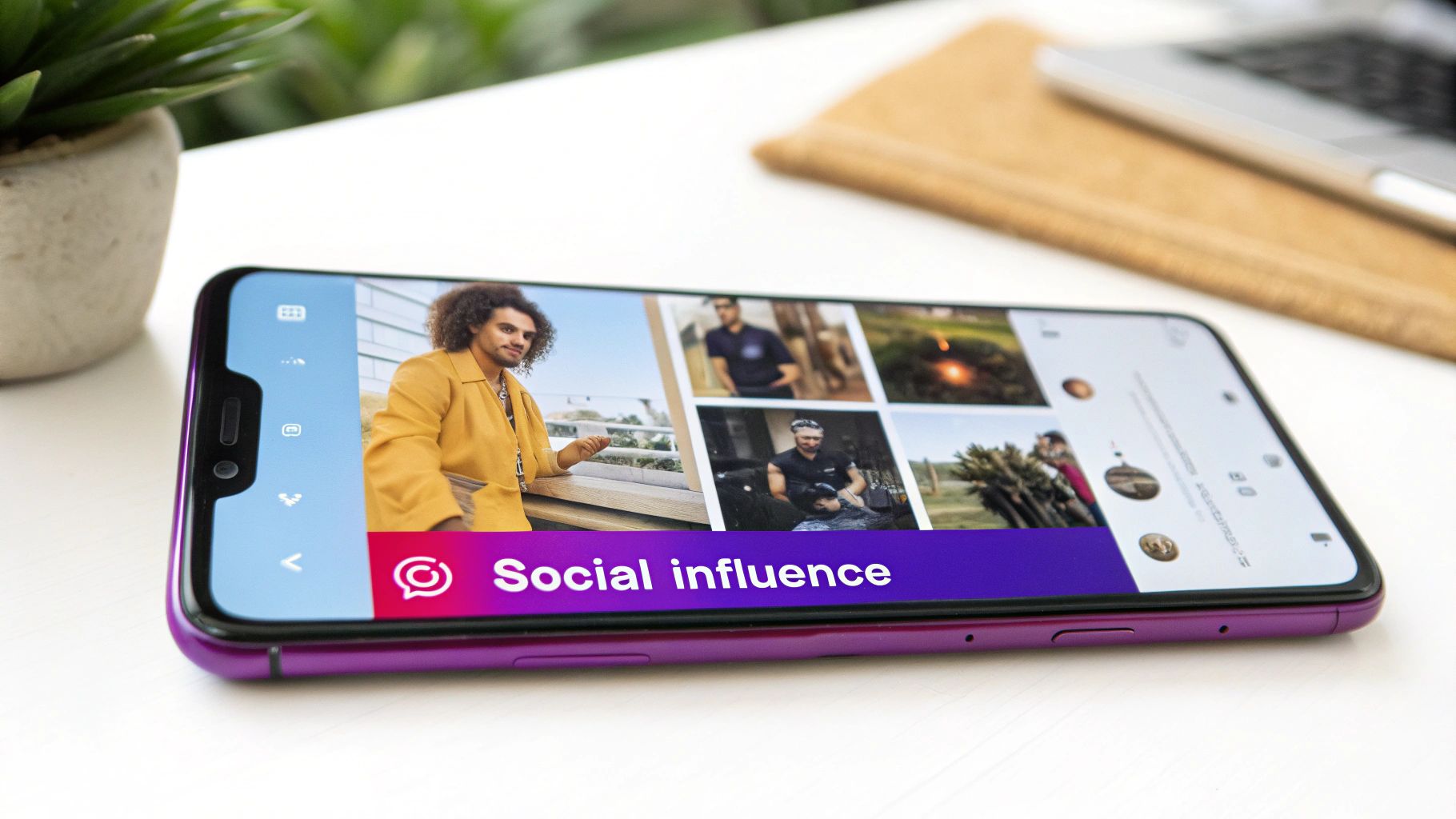10 Potent Marketing Strategies for Ecommerce (2025 Guide)
In the crowded digital marketplace, simply having great products isn't enough. Sustainable growth requires a multi-faceted approach, blending visibility with user experience and customer retention. This guide moves beyond generic advice to provide a comprehensive breakdown of the 10 most impactful marketing strategies for ecommerce that are driving real results today. Each strategy is a crucial component in building a resilient, profitable online business.
We'll explore the 'what,' 'why,' and 'how' of each tactic, from foundational SEO to advanced retargeting campaigns. The goal is to provide a clear, actionable framework you can implement immediately. To truly unlock your store's potential and establish a robust blueprint for growth, explore the latest trends and proven tactics in our comprehensive guide on Top Ecommerce Marketing Strategies for 2025.
Inside this article, you will find actionable steps, real-world examples, and practical insights to help you prioritize your efforts effectively. Whether you're a startup looking for your first hundred customers or an established brand aiming to scale, this blueprint will equip you with the knowledge to build a robust marketing engine that captivates, converts, and creates lasting customer loyalty. Let's dive into the strategies that will define your success.
1. Search Engine Optimization (SEO) for E-commerce
Search Engine Optimization (SEO) is a foundational digital marketing strategy for ecommerce, focused on increasing your store's visibility in organic search engine results. Unlike paid ads, SEO drives traffic that is "free," sustainable, and often has a higher conversion rate because it directly answers a user's query. It involves a multi-faceted approach, optimizing everything from your site's technical structure to the content on your product pages.
Effective e-commerce SEO means structuring your website logically, researching keywords with strong buyer intent, and creating unique, compelling product descriptions. For example, instead of targeting a broad term like "shoes," a brand might focus on a long-tail keyword such as "women's waterproof trail running shoes," capturing a highly motivated shopper. Online retailers like Zappos and REI have built empires by mastering this, using rich product details, customer reviews, and helpful buying guides to dominate search rankings for thousands of specific terms.
Key Implementation Steps
- Target Long-Tail Keywords: Use tools like Ahrefs or SEMrush to find specific, multi-word phrases that indicate a user is ready to buy. These have lower competition and higher conversion rates.
- Optimize Product and Category Pages: Ensure every page has a unique title tag, meta description, and content. Avoid using generic manufacturer descriptions, as this can be flagged as duplicate content by search engines.
- Enhance with User-Generated Content: Encourage and display customer reviews. This constantly adds fresh, relevant text to your pages, which search engines favor.
- Improve Site Performance: Focus on Google's Core Web Vitals to ensure your site loads quickly and provides a smooth mobile experience, both of which are critical ranking factors.
To better understand the investment and potential return, the following summary box breaks down the typical timeline and costs associated with implementing a robust e-commerce SEO strategy.

The data highlights that SEO is a long-term investment; while initial results can appear within a few months, the true benefit lies in the compounding, sustainable traffic it generates over a year or more.
2. Email Marketing and Automation
Email marketing is one of the highest-ROI marketing strategies for ecommerce, providing a direct line of communication to your customers. It focuses on building a proprietary email list and using automated sequences to nurture leads, recover lost sales, and drive repeat business. By segmenting your audience and personalizing messages, you can deliver highly relevant content that builds loyalty and significantly boosts customer lifetime value.

Unlike strategies dependent on third-party platforms, email gives you full ownership of your audience. Brands like Brooklinen master this by using automated abandoned cart sequences to recover 15-20% of otherwise lost revenue. Similarly, Dollar Shave Club built its empire on clever email campaigns that fostered a strong brand community. The key is moving beyond generic blasts to behavior-triggered communication that feels personal and timely.
Key Implementation Steps
- Build Your List with a Lead Magnet: Offer a compelling incentive like a 10% discount, free shipping, or exclusive content in exchange for an email address. This ensures you attract subscribers who are genuinely interested in your products.
- Set Up Automated Welcome and Abandoned Cart Series: A welcome series should onboard new subscribers and introduce your brand. An abandoned cart flow, triggered within an hour of abandonment, is critical for immediate revenue recovery.
- Segment and Personalize Your Campaigns: Group your audience based on purchase history, browsing behavior, or engagement level. Use this data to send targeted promotions and recommendations that resonate with each segment.
- Maintain List Hygiene: To ensure high deliverability and engagement, it's crucial to manage your subscribers effectively. You can discover more about professional email list management on rebusadvertising.com to keep your campaigns performing optimally.
3. Social Media Marketing and Influencer Partnerships
Social media marketing is a powerful strategy for e-commerce, using platforms like Instagram, TikTok, and Facebook to build a community, showcase products, and drive direct sales. It goes beyond simple posting; it involves creating engaging content, fostering authentic conversations, and leveraging partnerships with influencers who have already earned the trust of a target audience. This approach allows brands to reach customers where they spend their time, building brand loyalty and social proof.

The success of this strategy is exemplified by brands like Gymshark, which scaled rapidly by collaborating with fitness influencers, and Daniel Wellington, which used strategic Instagram partnerships to achieve global recognition. These companies understood that modern consumers value authenticity, and influencer recommendations feel more like advice from a trusted friend than traditional advertising. To maintain a competitive edge and resonate with younger audiences, it's crucial to understand and leverage the top short-form video trends dominating platforms like TikTok and YouTube Shorts.
Key Implementation Steps
- Focus Your Platform Presence: Concentrate on one or two social media channels where your target demographic is most active instead of spreading your efforts too thin.
- Start with Micro-Influencers: Partner with influencers in the 10k-100k follower range. They often have higher engagement rates, are more affordable, and offer a more authentic connection with their audience.
- Track Your ROI: Use unique discount codes or affiliate links for each influencer to accurately measure the sales and traffic generated from their campaigns.
- Empower User-Generated Content (UGC): Encourage customers to share photos and videos with your products. Repurposing this content (with permission) provides authentic social proof and reduces your content creation workload.
By combining compelling brand content with the trusted voice of influencers, e-commerce businesses can significantly accelerate brand awareness and drive tangible revenue growth.
4. Pay-Per-Click Advertising (Google Ads & Shopping)
Pay-Per-Click (PPC) advertising is a crucial marketing strategy for ecommerce that allows you to place ads directly in front of high-intent buyers. Unlike organic strategies that take time, PPC delivers immediate visibility by targeting users actively searching for products you sell. This model, where you pay only when a user clicks your ad, offers a direct and measurable way to drive qualified traffic and sales, making it a powerful tool for customer acquisition.
The most effective PPC channels for online stores are Google Ads and Google Shopping. Shopping campaigns are particularly potent, as they display product images, prices, and store names directly in search results, creating a visually compelling ad format. For instance, furniture giant Wayfair and pet supply retailer Chewy masterfully use Google Shopping campaigns to dominate their respective categories, ensuring their products appear prominently for thousands of relevant search terms and capturing ready-to-buy customers at the exact moment of their search.

Key Implementation Steps
- Prioritize Google Shopping: For most e-commerce businesses, start with Google Shopping campaigns as they typically offer a higher return on ad spend (ROAS) compared to standard text ads.
- Optimize Your Product Feed: Your product feed is the foundation of your Shopping campaigns. Ensure your product titles include relevant keywords, like brand, color, and size, to match user search queries.
- Implement Negative Keywords: Actively review your Search Terms report to find and exclude irrelevant search queries. This prevents wasteful clicks and improves your campaign's efficiency.
- Leverage Remarketing: Create tiered remarketing lists based on user engagement, such as "viewed product" or "added to cart but didn't purchase." Target these warm audiences with specific ads to encourage them to complete their purchase.
5. Conversion Rate Optimization (CRO)
Conversion Rate Optimization (CRO) is a systematic process for increasing the percentage of website visitors who complete a desired action, such as making a purchase. Instead of focusing on attracting more traffic, CRO maximizes the value of the visitors you already have. It involves analyzing user behavior, forming hypotheses about potential improvements, and A/B testing changes to site design, copy, and user flow to validate those ideas.
Effective CRO is one of the most high-impact marketing strategies for ecommerce because it directly boosts revenue from your existing traffic. For example, Amazon's patented one-click checkout was a monumental CRO success, drastically reducing friction and increasing sales. Similarly, Basecamp increased signups by 14% simply by simplifying its homepage and clarifying its value proposition. This data-driven approach turns your website into a constantly evolving sales machine, turning small, iterative improvements into significant profit gains over time.
Key Implementation Steps
- Analyze User Behavior: Use tools like Hotjar or Microsoft Clarity to watch session recordings and view heatmaps. Identify where users get stuck or drop off in the buying journey.
- Prioritize High-Impact Pages: Start optimizing pages with high traffic but low conversion rates, such as key product pages or the checkout process, for the quickest wins.
- Test One Element at a Time: Isolate variables by testing a single change, like a headline, a button color, or an image. This ensures you can confidently attribute the change in performance to your test.
- Focus on Reducing Friction: Simplify forms, clarify shipping costs upfront, and streamline the checkout flow. Every removed step or answered question can prevent a potential customer from abandoning their cart.
To effectively implement these steps, having the right software is crucial. You can learn more about the best conversion rate optimization tools on rebusadvertising.com to get started.
6. Content Marketing and Blogging
Content marketing is one of the most effective marketing strategies for ecommerce because it focuses on building trust and authority rather than direct selling. This approach involves creating valuable content like blog posts, buying guides, and how-to articles that attract and educate potential customers. By addressing common questions and pain points, you draw in an audience at the top of the funnel, establishing your brand as a go-to expert in your niche.
This strategy nurtures prospects by providing genuine value, which naturally leads to product recommendations and sales. For instance, Beardbrand built a multi-million dollar grooming empire primarily through its educational YouTube videos and blog posts that taught men how to care for their beards. This content attracted their target audience, built a loyal community, and drove traffic to their product pages without aggressive sales pitches, cementing their status as industry leaders.
Key Implementation Steps
- Create Topic Clusters: Build content around core topics central to your products. This establishes topical authority with search engines and helps users find related information easily.
- Target Informational Keywords: Use keyword research tools to find questions your target customers are asking. Create comprehensive, in-depth content (1,500+ words) that thoroughly answers these queries.
- Integrate Products Naturally: Embed relevant product recommendations within your helpful content. For example, a blog post on "How to Set Up a Home Gym" can seamlessly link to your dumbbell sets and resistance bands.
- Promote and Repurpose Content: Distribute your articles and guides through email newsletters, social media, and influencer outreach. Repurpose a long-form blog post into a video, infographic, or several social media updates to maximize its reach.
7. Retargeting and Remarketing Campaigns
Retargeting, also known as remarketing, is one of the most powerful marketing strategies for ecommerce because it focuses on converting visitors who have already shown interest in your brand. It uses tracking pixels to serve targeted ads to users who previously visited your site but left without making a purchase. This strategy keeps your brand top-of-mind as they browse other websites and social media platforms, effectively addressing the fact that most customers don't buy on their first visit.
This approach is highly efficient because it targets a warm audience familiar with your products. For example, Amazon excels at this by showing you the exact products you viewed in ads across the web. Similarly, Warby Parker effectively retargets users who abandoned their shopping carts with timely reminder ads, often including a small incentive to complete the purchase. By re-engaging these high-intent shoppers, you can significantly boost conversion rates and maximize your return on ad spend.
Key Implementation Steps
- Segment Your Audience: Don't treat all visitors the same. Create separate campaigns for different segments like general site visitors, specific product viewers, and cart abandoners.
- Use Dynamic Ads: Instead of generic brand ads, use dynamic retargeting to automatically show ads featuring the exact products a user viewed or added to their cart.
- Implement Sequential Messaging: Create a narrative with your ads. Start with a simple product reminder, follow up with a special offer like free shipping, and then introduce urgency with a limited-time message.
- Set Frequency Caps: To avoid ad fatigue and annoying potential customers, limit the number of times a person sees your ad to 3-5 impressions per week. For an in-depth guide on this approach, you can learn more about what retargeting advertising is on rebusadvertising.com.
8. Social Proof and User-Generated Content
Social proof is a powerful psychological trigger that leverages the actions and opinions of others to influence consumer behavior. This marketing strategy for ecommerce is built on trust, showing potential customers that real people have purchased, used, and loved your products. It encompasses everything from customer reviews and ratings to user-generated photos and video testimonials, creating authentic validation that branded content cannot replicate.
This approach effectively overcomes purchase hesitation by replacing uncertainty with confidence. For example, Warby Parker’s "Home Try-On" program brilliantly encourages customers to post photos of themselves wearing different frames on social media, generating a massive library of authentic user-generated content (UGC). Similarly, beauty brand Glossier built its empire by featuring real customer photos prominently, showing products on a diverse range of skin tones and types, making their marketing feel more like a community conversation than a sales pitch.
Key Implementation Steps
- Automate Review Requests: Use an email automation tool to send a review request 7-14 days after an order is delivered, when the customer's experience is still fresh.
- Showcase UGC Prominently: Create dedicated galleries on your product pages and homepage featuring customer photos and videos. Use a branded hashtag to collect this content from social media platforms like Instagram.
- Simplify the Submission Process: Make leaving a review or uploading a photo as frictionless as possible. Use simple, mobile-optimized forms and consider offering a small incentive, such as loyalty points or entry into a giveaway.
- Respond to All Feedback: Engage with both positive and negative reviews publicly. Responding professionally to criticism shows that you value customer feedback and can build even greater trust than a page of only five-star reviews.
9. Referral and Loyalty Programs
Referral and loyalty programs are powerful marketing strategies for ecommerce that transform existing customers into brand advocates and repeat buyers. Referral marketing incentivizes customers to share your products with their network, leveraging trusted word-of-mouth recommendations. Loyalty programs reward repeat business, significantly increasing customer lifetime value and fostering a strong sense of community around your brand.
These strategies are highly effective because acquiring a new customer can cost five times more than retaining an existing one. Sephora's Beauty Insider program is a prime example, using a tiered rewards system to encourage repeat purchases and build a massive, loyal customer base. Similarly, Dropbox's legendary referral program, which offered extra storage space to both the referrer and the new user, was a key driver of its exponential growth. These programs turn customer satisfaction into a direct acquisition and retention engine.
Key Implementation Steps
- Implement Double-Sided Rewards: Motivate both the referrer and their friend by offering a valuable incentive to each party. This structure, used by brands like Casper ($75 for the referrer, 25% off for the friend), dramatically increases participation.
- Make Sharing Effortless: Integrate one-click sharing buttons for email, social media, and messaging apps directly into customer account pages and post-purchase notifications. Use platforms like ReferralCandy or Smile.io to streamline this process.
- Promote the Program Aggressively: Ensure your program is highly visible. Feature it on your homepage, in email signatures, on order confirmation pages, and even on your product packaging to maximize awareness.
- Create Tiered Loyalty Levels: Gamify the experience by creating levels (e.g., Bronze, Silver, Gold) that customers can achieve through spending. Offer increasingly valuable perks at each tier to encourage them to spend more to unlock exclusive benefits.
10. Mobile Optimization and Progressive Web Apps
Mobile optimization is a non-negotiable marketing strategy for ecommerce, ensuring your store provides a seamless experience on smartphones and tablets. With mobile devices driving the majority of online traffic, this approach goes beyond simple responsive design. It prioritizes speed, thumb-friendly navigation, and streamlined checkout processes to cater to on-the-go shoppers. As search engines like Google now use mobile-first indexing, a superior mobile experience directly impacts your visibility and search rankings.
Progressive Web Apps (PWAs) elevate this concept, offering app-like functionality directly through a web browser without needing an app store download. Major retailers have seen tremendous success with this technology. For instance, AliExpress launched a PWA that increased conversions for new users by an astonishing 104%, while Lancôme’s PWA boosted their conversions by 17% after reducing load times significantly. These examples prove that a mobile-first approach is crucial for capturing sales and building loyalty in a mobile-dominated landscape.
Key Implementation Steps
- Prioritize Performance: Use tools like Google PageSpeed Insights to diagnose and fix issues. Aggressively compress images, implement lazy loading, and use modern formats like WebP.
- Simplify Mobile Navigation: Implement clear hamburger menus and ensure call-to-action buttons are large and easily tappable (at least 44x44 pixels) to create a frustration-free user journey.
- Streamline the Checkout: Reduce the mobile checkout process to as few steps as possible. Integrate one-click payment options like Apple Pay and Google Pay to minimize manual data entry.
- Consider a PWA: Evaluate implementing a PWA to offer advanced features like push notifications and offline access, which can significantly increase engagement and repeat purchases.
Marketing Strategies Comparison Matrix
| Search Engine Optimization (SEO) | Medium to High 🔄🔄 | Variable: tools & specialist support ⚡ | Long-term organic traffic growth 📊📊 | Brands seeking sustainable traffic | Cost-effective, high-intent traffic, brand authority 💡 |
|---|---|---|---|---|---|
| Email Marketing and Automation | Medium 🔄 | Moderate: platform + content creation ⚡ | High ROI ($36-$42 per $1) 📊⭐ | Direct customer engagement & repeat sales | Highly measurable, automation creates passive revenue ⭐ |
| Social Media Marketing & Influencer | High 🔄🔄🔄 | High: content, influencer costs ⚡⚡ | Variable, potential viral growth 📊 | Brand building, visual storytelling | Access to large audiences, social proof from influencers ⭐ |
| Pay-Per-Click Advertising (Google Ads) | Medium to High 🔄🔄 | High: ad spend + management ⚡⚡ | Immediate traffic & sales, scalable 📊 | Fast traffic & sales, high competition niches | Instant visibility, granular targeting ⭐ |
| Conversion Rate Optimization (CRO) | Medium to High 🔄🔄 | Moderate to High: tools + expertise ⚡ | 10-50%+ conversion lift 📊⭐ | Improving existing traffic performance | Data-driven, improves profitability without extra traffic 💡 |
| Content Marketing and Blogging | Medium 🔄 | Moderate to High: writers/editors ⚡ | Long-term organic growth 📊 | Top-funnel traffic and brand authority | Builds trust & SEO, supports multiple channels ⭐ |
| Retargeting and Remarketing Campaigns | Medium 🔄 | Medium: ad spend + setup ⚡ | 2-4x ROAS, higher conversion rates 📊⭐ | Recover abandoned carts & warm audiences | Cost-effective, targets warm prospects ⭐ |
| Social Proof and User-Generated Content | Low to Medium 🔄 | Low to Medium: platform + community ⚡ | 18-270% conversion uplift 📊⭐ | Building trust & reducing hesitation | Authentic content, boosts SEO & trust ⭐ |
| Referral and Loyalty Programs | Medium 🔄 | Low to Medium: software + rewards ⚡ | 25% higher retention, 16% higher LTV 📊 | Customer retention & advocacy | Low acquisition cost, increases repeat purchase ⭐ |
| Mobile Optimization & Progressive Web Apps | High 🔄🔄🔄 | High: development and testing ⚡⚡⚡ | Improved mobile conversions, SEO boost 📊 | Mobile-first commerce | Fast, app-like experience, critical for mobile traffic 💡 |
Building Your Integrated Marketing Machine
Navigating the landscape of modern ecommerce is no longer about finding a single "magic bullet" strategy. As we've explored, lasting success comes from building a resilient, interconnected marketing machine where each component amplifies the others. You've seen how a robust SEO foundation can drive organic traffic, which is then nurtured through sophisticated email automation and re-engaged via targeted retargeting campaigns. This isn't just a collection of tactics; it's a blueprint for a holistic growth engine.
The most critical takeaway is the power of synergy. Your content marketing efforts fuel your SEO and provide value for your email list. The social proof you cultivate through user-generated content directly impacts your conversion rates and adds authenticity to your PPC ads. Each of the ten strategies discussed-from technical mobile optimization to the human connection of loyalty programs-works best when it works together. The goal isn't to do everything at once, but to layer these marketing strategies for ecommerce intelligently over time.
Your Actionable Path Forward
The sheer number of options can feel overwhelming, but progress is about focused, incremental action. Instead of trying to master all ten strategies simultaneously, commit to a phased approach based on your brand's unique needs.
- Audit Your Current State: Where are your biggest leaks? If you have steady traffic but low sales, start with Conversion Rate Optimization (CRO). If your traffic is nonexistent, prioritize SEO and targeted PPC to build initial momentum.
- Master One, Then Add Another: Dedicate a quarter to truly mastering one or two foundational areas. For example, focus intensely on building your email list and optimizing your product pages with SEO. Once you have a functioning system, layer in a retargeting strategy to recapture lost sales.
- Commit to Data-Driven Decisions: Every strategy, from content creation to influencer partnerships, must be measured. Track your key performance indicators (KPIs) relentlessly. Use the data, not just gut feelings, to decide where to double down and what to adjust.
Ultimately, building a powerful ecommerce brand is a marathon, not a sprint. The key is to move from a scattered set of activities to an integrated system that creates a seamless customer journey. By strategically implementing these marketing strategies for ecommerce, you transform your brand from just another online store into a growth-oriented, customer-centric powerhouse poised for long-term success.
Ready to stop guessing and start building a cohesive, data-driven marketing engine? The experts at Rebus specialize in creating and executing integrated marketing strategies for ecommerce brands that drive real growth. Contact Rebus today to see how we can build a customized plan to turn your marketing efforts into your most powerful asset.
